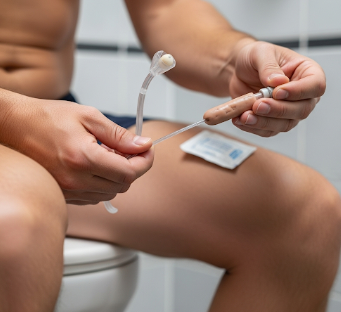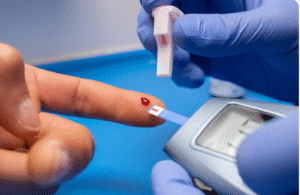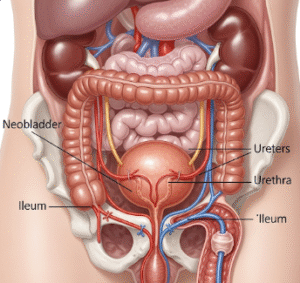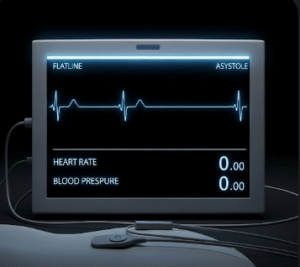Overview
Self-catheterization, also known as Clean Intermittent Catheterization (CIC), is a medical technique used to empty the bladder using a thin, flexible tube (catheter). It is commonly prescribed for people who are unable to urinate naturally due to medical conditions such as neurogenic bladder, spinal cord injury, multiple sclerosis, enlarged prostate, or urinary retention.
Unlike an indwelling catheter that remains inside the bladder, CIC is performed several times a day, and the catheter is removed after each use. This method is considered the gold standard for bladder management in patients who need long-term assistance with urination.
In Korea, CIC is widely practiced in specialized urology clinics and rehabilitation hospitals, where patients are trained by nurses and physicians to perform the procedure safely, independently, and hygienically.
What is Self-Catheterization (CIC)?
Clean Intermittent Catheterization is a technique that allows patients to control bladder emptying on their own. Using a lubricated sterile catheter, the patient inserts the tube into the urethra until it reaches the bladder, allowing urine to drain.
CIC is considered safe, effective, and minimally invasive compared to permanent catheters, significantly reducing risks of infection and complications.
What are the Benefits?
CIC offers many health and lifestyle benefits:
✅ Promotes independence – patients can manage their bladder without continuous medical support.
✅ Prevents bladder overfilling – reduces risk of urinary tract infections (UTIs) and kidney damage.
✅ Maintains normal lifestyle – allows patients to travel, work, and socialize with confidence.
✅ Lower infection risk – compared to indwelling catheters.
✅ Protects kidney function – prevents backflow of urine into the kidneys.
✅ Improves quality of life – restores confidence and dignity in bladder management.
Procedure Details
1) How should I prepare for Self-Catheterization?
Preparation involves both mental and physical readiness:
✦ Medical training: A healthcare professional demonstrates proper catheterization technique.
✦ Supplies: Sterile or single-use catheters, lubricant, and clean wipes are required.
✦ Hand hygiene: Wash hands thoroughly before each session.
✦ Positioning: Patients may sit, stand, or lie down depending on comfort and mobility.
✦ Schedule: Catheterization is typically done every 4–6 hours, or as prescribed by the doctor.
2) What happens during the procedure Self-Catheterization?
The CIC process usually follows these steps:
➤ Step 1: Wash hands thoroughly with soap and water.
➤ Step 2: Clean the genital area using mild soap, wipes, or antiseptic solution.
➤ Step 3: Open the catheter package and apply sterile lubricant to the tip.
➤ Step 4: Gently insert the catheter into the urethra until urine starts to flow.
➤ Step 5: Allow urine to drain fully into a toilet or collection container.
➤ Step 6: Once flow stops, slowly withdraw the catheter.
➤ Step 7: Dispose of the catheter if single-use, or clean it according to medical instructions if reusable.
The procedure is painless when performed correctly, though some patients may feel mild discomfort during insertion.
3) What happens after a Self-Catheterization?
After completing CIC:
• Dispose or clean the catheter as directed.
• Wash hands again to prevent infection.
• Record urine volume (if instructed by the doctor) to monitor bladder function.
• Resume normal activities – CIC takes only a few minutes and does not interfere with daily life.
⚠ Patients should follow the recommended frequency to prevent bladder overfilling, which can lead to complications.
Risks / Benefits
Risks of CIC include:
- ✦ Minor discomfort or urethral irritation.
- ✦ Urinary tract infections (if hygiene is not maintained).
- ✦ Occasional small amounts of blood in urine.
- ✦ Rare urethral injury if insertion is forceful.
Benefits include:
- ✅ Safer than indwelling catheters.
- ✅ Allows complete bladder emptying.
- ✅ Lowers risk of kidney complications.
- ✅ Improves patient freedom and independence.
Recovery and Outlook
CIC is not a “recovery” procedure but a long-term bladder management method.
➤ Short-term: Patients usually adapt after a few training sessions with medical staff.
➤ Long-term: CIC can be performed for years without major complications if proper hygiene is followed.
➤ Lifestyle: Patients can live normally, travel, and engage in physical activity without limitation.
➤ Prognosis: CIC helps maintain healthy kidney function and bladder safety throughout life.
When To Call the Doctor
Patients should seek medical help if they notice:
⚠ Persistent pain during catheterization.
⚠ Fever, chills, or burning sensation (possible UTI).
⚠ Blood in urine beyond small temporary spotting.
⚠ Difficulty inserting the catheter or blocked urine flow.
⚠ Unexpected changes in urine color, odor, or volume.
Best Korea Option / Process
Korea provides world-class training and support for CIC patients:
✦ Specialized urology centers offer hands-on training by experienced nurses.
✦ Advanced catheter technology (hydrophilic-coated, pre-lubricated, compact catheters) is widely available.
✦ Multilingual support for international patients ensures clear understanding of techniques.
✦ Affordable training programs compared to Western countries.
✦ Long-term follow-up – Korean clinics provide ongoing monitoring for kidney and bladder health.
This makes Korea a trusted destination for patients seeking CIC training and long-term care solutions.
Highlights of Self-Catheterization (CIC) in Korea
- ✅ Gold standard for long-term bladder management.
- ➤ Safe, effective, and reduces infection risk.
- ✦ Promotes independence and confidence in daily life.
- ➤ Supported by advanced hospitals and expert urologists in Korea.
- ✅ Affordable, with high-quality patient training and follow-up.













